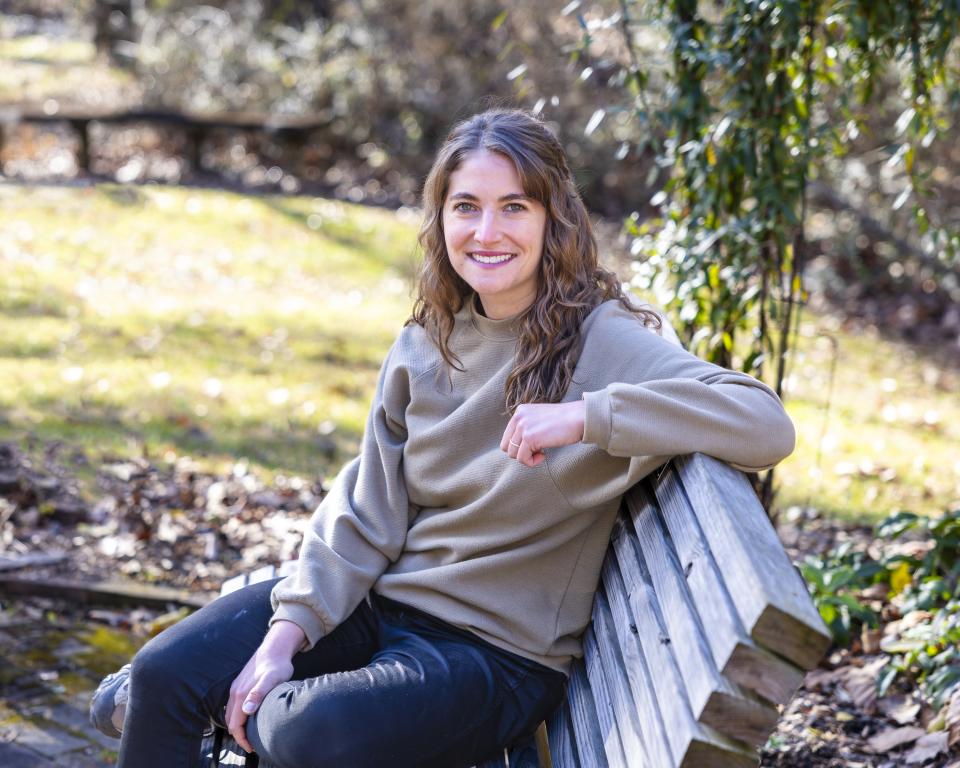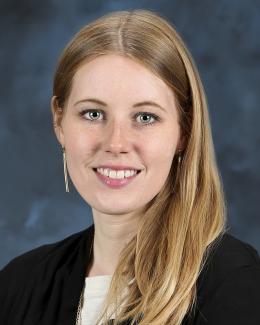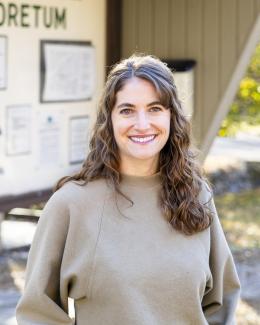
If anyone can see the forest for the trees, it’s KC Cushman.
Cushman, a Liane B. Russell Fellow at the Department of Energy’s Oak Ridge National Laboratory, has been studying trees and forests in an effort to help humans care for them and improve the health of the planet.
Cushman decided as a college student that studying the world’s forests might be a good way to help mitigate the effects of climate change and literally help save the earth. She soon came to appreciate “how quickly our world is changing and all of the work that is needed to be done to understand that change and make better decisions, to ensure that we are able to continue to live on this planet,” she said.
It’s one thing to stand next to an arboreal giant in a tropical jungle of thousands of them and try to measure its height and overall health from the ground—but quite another to try to determine that for all the forest’s botanical inhabitants. So Cushman’s skill and interest in engineering and math led her to ORNL, where, as a Distinguished Staff Fellow, she joined a research program dedicated to determining how to use technology—especially drones with sensitive sensors and instruments—to complement field and satellite data.
Using lidar, or light detection and ranging, Cushman helps develop innovative approaches to study forest ecosystems across spatial and temporal scales. It’s important, she said, because “satellite data usually have coarse resolution. Bringing in other types of data is necessary to understand what we can and can’t see from space.”
Since joining ORNL in October, Cushman works with her mentor, Anthony Walker, a senior research ecologist in the Ecosystem Processes group, which is part of the Environmental Sciences Division. Her fellowship research focuses on better understanding forest disturbance dynamics in the Southeastern United States, which has high carbon sequestration potential in natural systems but also experiences multiple, interactive disturbances that influence carbon dynamics including wildfires, insect outbreaks, large storms and drought. Cushman will use multiple cutting-edge remote-sensing platforms — ground-, air- and space-based — to provide an understanding of disturbance recovery across spatial scales in the Southeast.
With deep roots in Oak Ridge, Tennessee, Cushman grew up in an ORNL family. Her father, Bob, and mother, Janet, were both ecologists who worked at the lab, and her brother is an ORNL engineer. The apple — or acorn — does not, as they say, fall far from the tree.
As a student at Oak Ridge High School, Cushman had a calculus teacher, Benita Albert, who instilled a love of math along with confidence. With Albert’s support, Cushman scored a summer internship at ORNL in 2007 that allowed her to explore her interest in engineering. Another teacher providing mentorship was Todd Livesay, who taught technology education at Robertsville Middle School and organized the RMS chapter of the Technology Student Association. Cushman was heavily involved with the group throughout middle and high school, learning about leadership development and participating in competitive events related to technology. In addition, Cushman also played the flute and piccolo in the high school marching band.
Weaving engineering, biological studies to tackle climate change
After high school, she enrolled at Swarthmore College and started taking STEM classes, thinking engineering might be a great way to combine different areas of science and apply them to a real-world problem. However, she was soon drawn to biology and decided to branch out. Her biomechanics professor, Rachel Merz, advised her through this change in career focus.
“She taught me that I could pursue research and biology in a way that allowed me to use tools from engineering and math and computer science that I just found really interesting,” Cushman said.
Cushman was involved in several student groups at Swarthmore focused on sustainability, technology and environmental justice, which inspired her to strive for a career where she could do research that would be relevant to global climate change. Thus was born a career using engineering and math skills to understand biological systems.
After graduating, Cushman landed a two-year internship with Helene Muller-Landau at the Smithsonian Tropical Research Institute in Panama, where she did fieldwork on ForestGEO plots to understand the forest ecology. ForestGEO is a global network of forest research sites dedicated to advancing long-term study of the world’s forests. Every five years, the Panama plot’s more than 200,000 trees are measured, analyzed and studied to help keep tabs on their health. Cushman measured trunks, compared them across different forests and helped monitor their health — all from the ground.
The ForestGEO work was her “first experience trying to better quantify carbon stored in large trees. I was a boots-in-the-mud ecologist, and I loved being in the field, traveling to different places and meeting people who worked with different plots. But I did find it unsatisfying in some ways,” Cushman said.
Contributing to her dissatisfaction was knowing that “a person on the ground isn't the right perspective to understand some of those questions about tree size and carbon cycling over large scales.”
Following her time at Swarthmore, Cushman attended graduate school at Brown University, where she began work in a fledgling lab developing methodologies for using drones for lidar and other diagnostic studies. She was excited to learn how those sensors worked and how she could use them to do ecology research.
For her doctoral thesis in ecology and evolutionary biology, she explored the use of novel remote-sensing tools for measuring 3D structures and carbon dynamics in forests. Cushman demonstrated the value of using drones to complement traditional field- and satellite-based measurements of forests. Using drones for targeted, landscape-scale data collection also allowed her to demonstrate that optical satellite data may underestimate tropical forest disturbance frequency and to explore how new estimates of forest biomass from spaceborne lidar could be obtained.
After completing her doctorate at Brown, Cushman returned to Panama for a two-year postdoctoral fellowship, again for the Smithsonian, working with the DOE Next Generation Ecosystem Experiments-Tropics, or NGEE-Tropics. The 10-year project focused on transforming the way Earth system models depict how tropical forests will respond to changing environmental conditions. She used drones to monitor the forest canopy and understand how variation in soils and topography influence rates of tree damage and mortality.
Moving to a higher orbit for Earth studies
With fieldwork under her belt, Cushman continued postdoctoral work at NASA’s Jet Propulsion Laboratory at the California Institute of Technology, helping to equip a satellite for Earth studies. She contributed to calibration and validation of spaceborne estimates of biomass for the NISAR, or NASA-ISRO Synthetic Aperture Radar, mission, a joint project between NASA and the Indian Space Research Organization, which aims to launch a dual-frequency SAR on an Earth observation satellite. It is scheduled to launch in 2024.
Cushman said her research is motivated by the importance of forests for understanding and predicting global cycles of carbon, water and nutrients.
“To understand carbon and forests, you really have to think about individual trees — how tall they are, how big the trunks are, how they angle their leaves — but you also have to think about communities of trees — how different species compete with each other, how they’re influenced by storms and soils and how they’re affected by longer-term climate trends.”
All these dimensions can affect carbon in the atmosphere, and how trees and forests respond to climate change. “I can use remote-sensing tools to look at both individual trees and larger-scale patterns over time and get a picture of how ecosystems are functioning and changing,” she said. That’s another example of seeing the forest and the trees.
Cushman’s fellowship research at ORNL aligns with that. She utilizes ground, air and space platforms to study trees and forests in the Southeast. The results “will allow us to better monitor and predict the effects of disturbances on natural systems,” she said.
If it’s possible for a tree-loving scientist to have one favorite species (spoiler: it’s not), Cushman’s might be Ceiba pentandra, or Kapok Tree, for “its huge, impressive buttress roots, which I got to study in my first project as an intern with the Smithsonian. Ceiba also reaches the largest canopy area of any species where I worked in Panama.”
When she’s not studying forests, Cushman enjoys cooking, she loves to run or hike in the plentiful trails around Oak Ridge and East Tennessee, and plays with her cat, Arden, who also loves trees. She is an avid viewer of reality television shows to take a break from, well, reality. In graduate school, she ran a fantasy league for The Bachelor, a TV show she said still helps her relieve workday stress. Another escape she enjoys is reading fiction, and Cushman is fond of the fantasy, science fiction and psychological thrillers of N.K. Jemisin and Shirley Jackson.
So, if a tree falls in a forest, Cushman may have a drone or satellite trained on it, and she can confirm that, yes, it does make a sound.
ORNL’s Distinguished Staff Fellowship program aims to cultivate future scientific leaders by providing dedicated mentors, world-leading scientific resources and enriching research opportunities at a national laboratory. Fellowships are awarded to outstanding early-career scientists and engineers who demonstrate success within their academic, professional and technical areas. Fellowships are awarded for fundamental, experimental and computational sciences in a wide range of science areas. Fact sheets about ORNL fellows are available here.
UT-Battelle manages ORNL for DOE’s Office of Science, the single largest supporter of basic research in the physical sciences in the United States. DOE’s Office of Science is working to address some of the most pressing challenges of our time. For more information, visit energy.gov/science. — Lawrence Bernard



